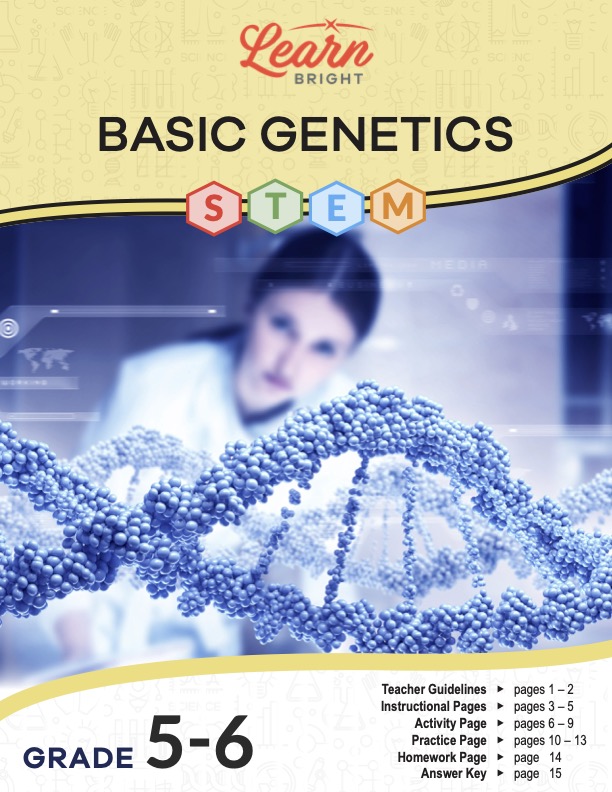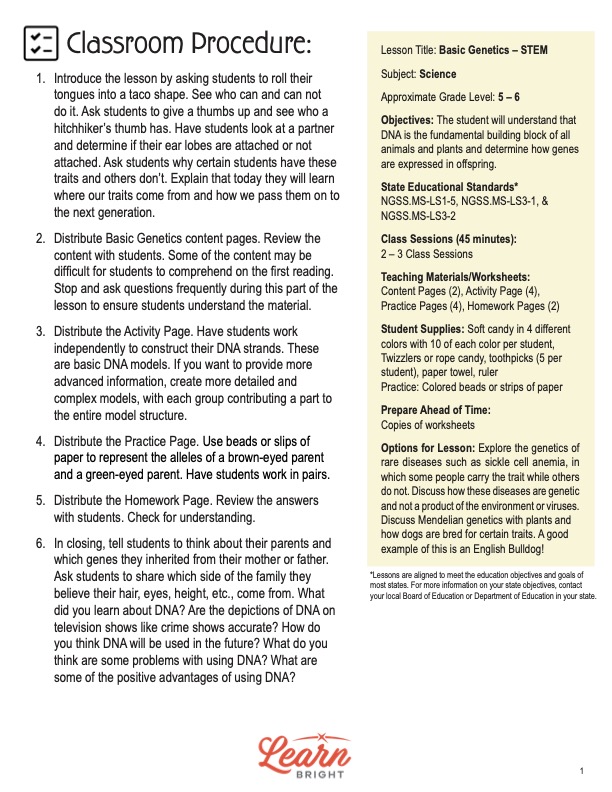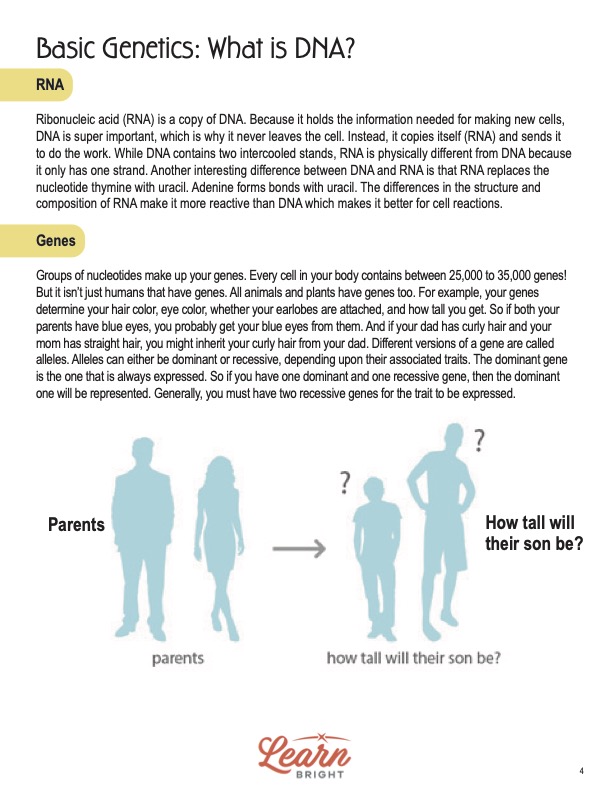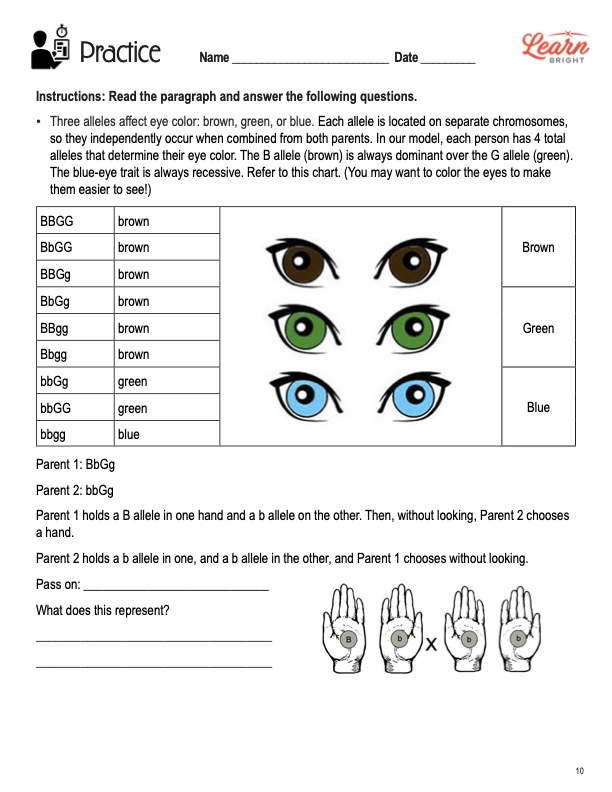Description
What our Basic Genetics STEM lesson plan includes
Lesson Objectives and Overview: Basic Genetics STEM introduces students to the fundamentals of genetics. Students will learn about DNA and how it is the building block of all living things. They will also discover how genes are expressed in the offspring of two parents. This lesson is for students in 5th grade and 6th grade.
Classroom Procedure
Every lesson plan provides you with a classroom procedure page that outlines a step-by-step guide to follow. You do not have to follow the guide exactly. The guide helps you organize the lesson and details when to hand out worksheets. It also lists information in the yellow box that you might find useful. You will find the lesson objectives, state standards, and number of class sessions the lesson should take to complete in this area. In addition, it describes the supplies you will need as well as what and how you need to prepare beforehand. For this lesson, you will need soft candy, some kind of rope candy such as Twizzlers, toothpicks, paper towels, rulers, and colored beads or colored strips of paper.
Options for Lesson
There are suggestions in the “Options for Lesson” section of the classroom procedure page for additional activities or ideas. One idea is to explore the genetics of rare diseases like sickle cell anemia. Discuss how some people carry the trait while others do not. You could further discuss how these diseases are genetic and not a product of viruses or the environment. Another option is the talk about Mendelian genetics with plants and how people breed dogs for certain traits. The English bulldog is a great example of this.
Teacher Notes
The paragraph on this page provides a little more information or guidance on what to expect from the lesson. It explains that this lesson is meant to engage students in a fun way as they learn about genetics. You can use the blank lines to record any thoughts or ideas you have as you prepare.
BASIC GENETICS STEM LESSON PLAN CONTENT PAGES
What Is DNA?
The Basic Genetics STEM lesson plan contains three content pages. It first introduces students to deoxyribonucleic acid, or DNA, which is the genetic information inside our cells. DNA resides in the chromosomes and provides instructions for how to create a human (or any other living thing). Students could compare this information to the code of a video game. DNA is the stuff that makes us who we are.
More specifically, DNA is a molecule that contains information on how to create proteins, kind of a like a recipe. Proteins, water, sugars, and fats make our bodies function. When our cells divide, strands of DNA repeatedly replicate themselves in the same pattern.
A molecule of DNA contains two strands that wind around each other. One strand comes from the mother and one from the father. The molecule looks like a twisted ladder in a spiral shape called a double helix. Each strand is held together by bonds between four different chemicals called nucleotides. The nucleotides are basically the rungs of the ladder. The four nucleotides are adenine, thymine, guanine, and cytosine.
Because DNA holds all the information needed for making new cells, it never leaves the cell. Instead, it copies itself as RNA (ribonucleic acid) and sends the RNA to do the work. RNA is physically different from DNA because it only has one strand. It also replaces the nucleotide thymine with uracil. The differences in the structure and composition of RNA make it more reactive than DNA, which then makes it better for cell reactions.
Basic Genetics
Groups of nucleotides make up a person’s genes. Every cell in the body contains between 25,000 and 35,000 genes. Our genes determine our hair color, eye color, whether our earlobes attach, and how tall we will be. If two parents both have blue eyes, their offspring will most likely have blue eyes as well. If one parent has straight hair and the other has curly, their offspring could have one or the other depending on which trait is dominant.
Different versions of a gene are called alleles. Alleles are either dominant or recessive, depending on the associated traits. Dominant genes are those that are always expressed. If someone has a dominant gene and a recessive gene for a given trait, they will manifest the dominant gene. Generally, a person must have two recessive genes for a given trait in order for it to be expressed.
To illustrate this point, the lesson provides an example using a Punnett square to represent the dominant and recessive genes with hair color. If a person’s mom has one gene for brown hair (B) and one for blonde hair (b), she could pass the brown or blonde to the person. And if the dad has a gene for brown hair (B) and one for red hair (r), he could likewise pass on either.
Brown hair is the dominant gene, so it will be the one expressed when paired. Blonde hair is more dominant than red, so it will be expressed if paired with the red hair gene. The Punnett square shows how likely it is that the offspring of these parents would have brown hair or blonde hair. It is impossible to have red hair, but they might inherit the red hair gene.
DNA also creates chromosomes. A nucleus in humans contains 46 chromosomes, or 23 pairs of chromosomes, of different lengths and patterns. The first 22 pairs are called autosomes, and the last is called the sex chromosome as it determines a human’s sex. Hundreds and even thousands of genes reside in a single chromosome.
BASIC GENETICS STEM LESSON PLAN WORKSHEETS
The Basic Genetics STEM lesson plan includes three worksheets: an activity worksheet, a practice worksheet, and a homework assignment. Each one will reinforce students’ comprehension of lesson material in different ways and help them demonstrate when they learned. Use the guidelines on the classroom procedure page to determine when to distribute each worksheet to the class.
GUMMY BEAR DNA STRANDS ACTIVITY WORKSHEET
The activity requires students to create a strand of DNA using gummy bears to represent the four nucleotides. Adenine (A) is yellow, guanine (G) is red, thymine (T) is green, and cytosine (C) is clear. A always pairs with T, and G always pairs with C. Students can use toothpicks to make their colored pairs. They will create six pairs of A and T bonds and six pairs of C and G bonds. Twizzlers or some other long, soft candy will create the sides of the DNA ladders.
Students will first place their Twizzlers about 8 cm apart and ensure the two sides are parallel. Then they will attach their toothpick pairs into the sides evenly every 1 or 2 cm down the length of the Twizzlers. Finally, they will twist the candy into a double helix shape. Once students finish creating their DNA, they will respond to four prompts on the second activity worksheet page.
BASIC GENETICS STEM PRACTICE WORKSHEET
Students will work with a partner to complete the practice worksheet. First, they must read the paragraph at the top of the first page about the alleles that affect eye color. A chart provides them with information on which allele pairings will yield the different eye colors. For instance, because brown is dominant, any combination containing a brown eye color allele will express brown eyes.
Students will pretend to represent a parent with certain alleles. The first parent (Parent 1) will hold a B allele in one hand and a b allele on the other. Without looking, Parent 2 will choose a hand without looking. Then they will switch. Parent 2 will hold a b allele in one hand and a b allele in the other. Parent 1 will then choose a hand without looking. They will then write the pair next to the “Pass on” prompt and explain what it represents.
They will then repeat this procedure for the G alleles where each parent holds a G in one hand and a g in the other. Again, they will write the pair on the “Pass on” line. Then they will combine the two so that there is a total of four letters to represent the offspring’s eye color.
Students will repeat this process until they create eight “children” and write down the letter combination (genotype) and eye color (phenotype) of each one. Next they will use a Punnett square to determine the likelihood that a bird will have a big or small beak according to the genes from its parents.
PUNNETT SQUARE HOMEWORK ASSIGNMENT
For the homework assignment, students will practice using Punnet squares to determine the probability of inheriting certain traits. There are four prompts to respond to, as well as a Punnett square for them to fill out.
Worksheet Answer Keys
The lesson plan contains answer keys for the three worksheets. All the correct answers are in red to make it easier to compare them with students’ responses. Given the nature of the some of the prompts, answers may vary. If you choose to administer the lesson pages to your students via PDF, you will need to save a new file that omits these pages. Otherwise, you can simply print out the applicable pages and keep these as reference for yourself when grading assignments.









